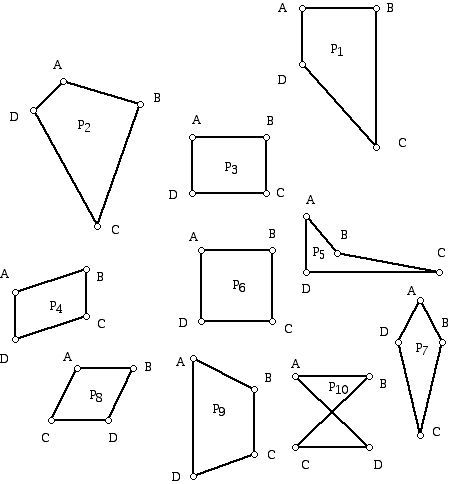
The Complex World of Quadrilaterals
Prepared by:
Joseph Malkevitch
Department of Mathematics
York College (CUNY)
Jamaica, New York 11451
email:
malkevitch@york.cuny.edu
web page:
http://york.cuny.edu/~malk/
Intuitively, one can think of a quadrilateral as 4 points, called the vertices of the quadrilateral, which are joined by line segments, called the edges or the sides of the quadrilateral. For the moment we will think of the points as lying in a single plane with no 3 of the points lying on a single line.
Below (Figure 1) are some shapes that would be quadrilaterals under this definition. As you can see there are a wide variety of ways that one might describe these polygons. Some of them have sides which lie along parallel lines. (We say that two lines in a plane are parallel if they have no point in common.) Some of these polygons have sides of equal length and some have angles of equal size. Some contain one or more right angles. Some have pairs of adjacent sides equal in length. In describing these figures one can also take into account information about the two line segments that are not edges of the quadrilateral. These segments are known as the diagonals of the quadrilateral, which can intersect or not. The diagonals of a quadrilateral can even lie along lines which are parallel! Quadrilaterals can be convex or non-convex and have self-intersecting sides or not.
In light of the very varied phenomena that we can see in different types of quadrilaterals, it is convenient to "invent" words to describe different kinds of quadrilaterals. Examples of these invented words are: square, rectangle, parallelogram, kite, trapezoid, and rhombus. However, different people (books) often define these words in different ways. Sometimes these different definitions are "equivalent" in the sense that they define exactly the same collection of quadrilaterals.
For example, here are three different definitions for a quadrilateral to be a parallelogram.
Definition 1: A quadrilateral is a parallelogram if it has pairs of opposite sides equal in length.
Definition 2: A quadrilateral is a parallelogram if it has pairs of opposite sides which lie on parallel lines.
Definition 3: A quadrilateral is a parallelogram if it has pairs of opposite angles equal.

Figure 1 (Quadrilaterals)
Can you give a convincing argument that these three definitions all describe the same collection of quadrilaterals?
Here is another way to see how rich the study of quadrilaterals can be. The discussion is based on some ideas of the distinguished geometer Branko Grünbaum. Suppose we consider the 4 sides of a quadrilateral and look at how long these sides are. Since we have 4 lengths, we can consider the partitions of the number 4, namely, {4}, {3, 1}, {2, 2}, {2, 1, 1}, and {1, 1, 1, 1}. We can interpret these partitions in the following way. The partition {2, 2}, for example, will mean that there are two different edges of one length, and 2 different edges of another length; {4} will mean there are 4 edges of the same length, while {3, 1} will mean there are 3 sides of the quadrilateral of one length and 1 side of another length. Thus, every quadrilateral can be classified into one of 5 types by edge length. Notice also an additional complexity. for the {2, 2} partition one can have the edges which have the same length adjacent or not.
However, the same analysis using partitions can be carried out by looking at the situation with regard to angle size! Thus, every quadrilateral can be classified into 5 types by angle size. Applying the fundamental principle of counting, there are 25 different types of quadrilaterals which might exist based on the lengths of sides and sizes of angles. Of course, it is possible that not all of these 25 categories actually have quadrilaterals that might satisfy the conditions involved.
Grünbaum's classification actually led to 49 potential types of quadrilaterals because he took into account the the different ways edges/angles could be placed within a partition type.
Question 1
Give a precise definition of the word "rectangle." What alternate definitions might one also use?
Question 2
Give a precise definition of the word "rhombus." What alternate definitions might one also use?
Question 3
Give a precise definition of the word "trapezoid." What alternate definitions might one also use?
Give a precise definition of the word "square." What alternate definitions might one also use?
Question 4
For each of the 10 quadrilaterals that appear in Figure 1, for each of the 25 types that Grünbaum suggested, determine which type it belongs to.
Question 5
Give some examples of types of quadrilaterals (in the scheme based on partitions inspired by Grünbaum's classification ) which you can demonstrate can not exist.
Question 6
What problems arise if you try to extend the definitions and concepts involving quadrilaterals defined as plane polygons with no 3 vertices on a line to:
a. allow three or more of the vertices of the quadrilateral to be on a single line?
b. remove the requirement that the vertices all lie in a plane?
Question 7
Given a quadrilateral, join with line segments the midpoints of adjacent sides of the quadrilateral. Do you see a pattern? If the original quadrilateral has more "symmetry" than having 4 sides of unequal length, can you determine if one gets a more "symmetrical" result?
Question 8
What properties of quadrilaterals are disregarded in the analysis based on partitions for angles and side lengths?
References
Grünbaum, B., The angle-side reciprocity of quadrangles, Geombinatorics, 4 (1995) 115-118.